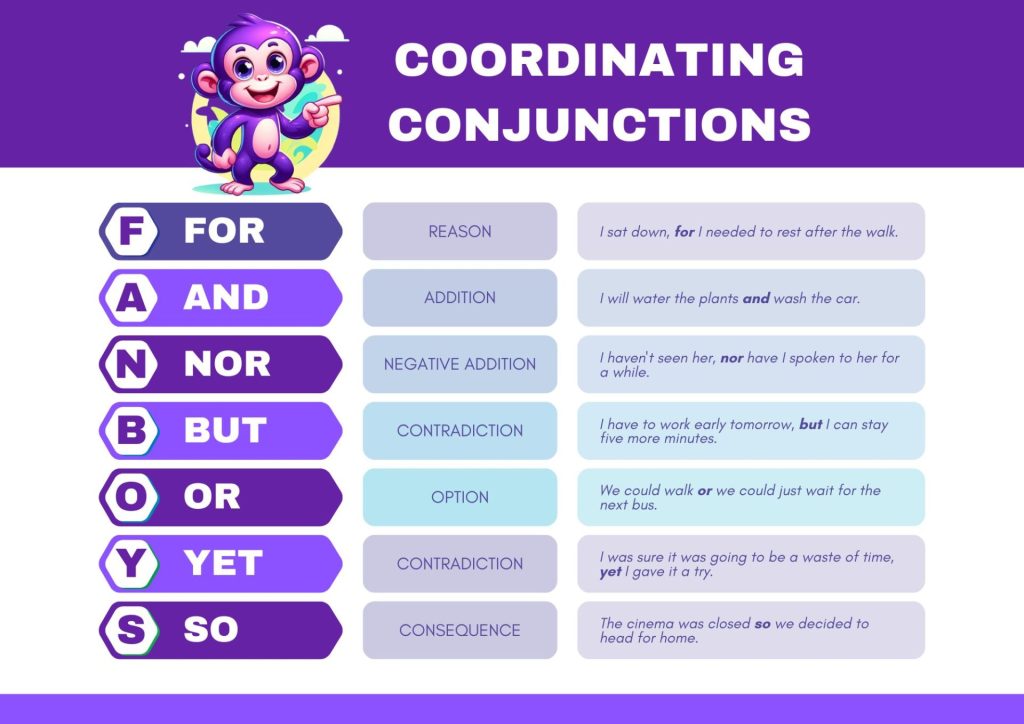What are Coordinating Conjunctions? – The Concept of FANBOYS
Table of Contents
Introduction
What are Coordinating Conjunctions?
Coordinating conjunctions are an essential part of the English language, serving as connectors that join words, phrases, or independent clauses. Understanding how to use coordinating conjunctions effectively can greatly enhance your writing and communication skills.
Analogy of Definition
The FANBOYS Acronym
The term “FANBOYS” is an acronym that represents the seven coordinating conjunctions in English: For, And, Nor, But, Or, Yet, So. These conjunctions play a crucial role in connecting various elements of a sentence and establishing relationships between them.

Method
How to Use Coordinating Conjunctions?
Using Coordinating Conjunctions to Join Single Words
Coordinating conjunctions can be used to connect single words within a sentence. For example, “I need to buy apples and bananas for the fruit salad.” In this sentence, the coordinating conjunction “and” joins the words “apples” and “bananas” to express the need for both items.
Using Coordinating Conjunctions to Join Phrases
Similarly, coordinating conjunctions can connect phrases to create meaningful and coherent sentences. For instance, “She enjoys reading novels or watching movies in her free time.” Here, the coordinating conjunction “or” links the phrases “reading novels” and “watching movies” to convey different leisure activities.
Using Coordinating Conjunctions to Join Independent Clauses
One of the most common uses of coordinating conjunctions is to join independent clauses, which are complete sentences on their own. For example, “I wanted to go to the concert, but I couldn’t get tickets in time.” In this sentence, the coordinating conjunction “but” connects the independent clauses “I wanted to go to the concert” and “I couldn’t get tickets in time.”
Commas and Coordinating Conjunctions
When coordinating conjunctions are used to join independent clauses, it is important to place a comma before the conjunction. This helps to clearly separate the two clauses and avoid confusion. For instance, “She studied hard for the exam, so she passed with flying colors.”
Examples
Examples of Coordinating Conjunctions
1. I want to travel to Europe, but I need to save more money.
2. You can have cake or ice cream for dessert.
3. He is neither tall nor short, but of average height.
Quiz
Tips and Tricks
1. Use them to join independent clauses
Tip: Coordinating conjunctions are commonly used to connect two independent clauses (complete sentences) to create compound sentences. For example: “She wanted to go to the party, but she had too much homework.”
2. Remember their meanings
Tip: For: Indicates a reason or purpose, And: Adds information or lists items, Nor: Presents a negative choice or an alternative negative condition, But: Shows contrast or contradiction, Or: Presents an alternative or a choice, Yet: Indicates contrast or introduces a surprising fact, So: Indicates result, consequence, or inference.
3.Avoid comma splices
Tip: When joining two independent clauses with a coordinating conjunction, use a comma before the conjunction. Example: “She loves to read books, and she enjoys writing stories.”
4. Vary your conjunctions
Tip: While “and” and “but” are frequently used, don’t hesitate to use other coordinating conjunctions like “so”, “or”, “nor”, etc., to add variety and nuance to your writing.
5.Understand sentence flow
Tip: Consider the flow and rhythm of your sentences when choosing coordinating conjunctions. Some conjunctions may create a smoother flow, while others may introduce a pause or emphasize contrast.
Real life application
Story: “The FANBOYS Adventure of Sarah and Mark”
Sarah and Mark, two friends with a passion for writing, embarked on an adventure to explore the practical applications of coordinating conjunctions in real-life scenarios.
Scenario 1: The Travel Blog
Sarah and Mark decided to start a travel blog to document their adventures. They used coordinating conjunctions to describe their experiences, such as “We visited the Eiffel Tower and explored the Louvre Museum in Paris.”
Scenario 2: The Recipe Collection
As food enthusiasts, Sarah and Mark compiled a collection of recipes for their blog. They utilized coordinating conjunctions to list ingredients and cooking instructions, such as “Mix the flour and sugar, then add the eggs and vanilla extract.”
Scenario 3: The Interview Transcript
During an interview with a local artist, Sarah and Mark used coordinating conjunctions to connect the artist’s thoughts and ideas, such as “The artist explained her creative process and shared her inspiration for the latest artwork.”
FAQ's
Like? Share it with your friends
